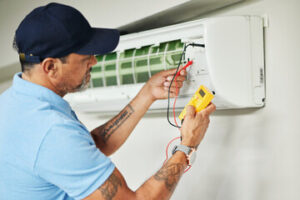Preventive Maintenance For Your AC
Many minor AC problems can be easily fixed by homeowners. Keeping your system up to date with preventive maintenance will ensure that it lasts longer.

Getting routine service in the spring and fall can minimize the need for costly repairs or replacements. Learn your system’s basics at AC Repair Woodland Hills to understand why maintenance is so important.
The compressor is the heart of your air conditioning system. It compresses atmospheric air before transferring it to the evaporator coil to cool your home. Without a functioning compressor, your AC cannot cool your home.
Many different issues can cause problems with your compressor. One of the most common is clogged suction lines that hinder the flow of refrigerant throughout your unit. This can lead to a buildup of residue, grime, and minerals that will ultimately cause your compressor to fail.
Another issue is an electrical problem. This can cause acids to build up in your system, which is not good for the compressor. This is why scheduling regular air conditioning tune-ups with a licensed technician is important. They will be able to inspect the unit for acid buildup and repair any wiring or fuses that could wreak havoc on your compressor and other parts of your home air conditioner.
The most common type of AC repair is replacing the compressor’s capacitor. Capacitors degrade slowly over time, causing them to lose startup power. It’s best to replace them proactively about every five years. Using needle-nose pliers, remove the old capacitor wires from their terminal tabs. Take a photo of the connections before disconnecting anything, as this will make the process easier. Once the old capacitor is removed, disconnect the wires from the corresponding tabs on the new one. Once the wires are disconnected, the new capacitor can be plugged into the compressor. Ensure that the female crimp connectors snap tightly onto the new capacitor tabs. This is a great time to use a rubber sealant, which will help prevent leaks in the future.
Evaporator Coil
The evaporator coil is part of your air conditioner’s heat transfer system that cools your home. It absorbs heat from your home’s air and transfers it to the condenser coil, which then releases it outdoors.
Like any part of your AC system, the evaporator coil needs routine maintenance to ensure its proper function. This includes inspection, cleaning and disinfection with EPA-approved biocides to prevent mold growth, which inhibits the coil’s ability to effectively transfer heat.
Corrosion is another common problem that can impact your air conditioner evaporator coil. Over time, aluminum and copper materials can corrode and weaken the coil’s outer lining. This weakening can lead to leaks. If left unchecked, the loss of refrigerant can significantly reduce your cooling system’s efficiency, and it will not be able to cool your home properly.
A professional HVAC technician can check for refrigerant leaks and repair or replace your evaporator coil. He or she will also drain and refill the system with new refrigerant. This requires specialized tools and training that are only available to certified technicians.
You may be tempted to try a DIY evaporator coil replacement, but it is not recommended. This is a complicated job that involves the risk of damaging your cooling system’s compressor and causing further problems. If you do damage your ac unit, you could end up paying for a costly and time-consuming repair or even needing to install a new unit.
The cost of a new evaporator coil can vary greatly depending on the type of AC unit you have, its SEER rating and other factors. However, the average evaporator coil costs between $100 and $300. If your evaporator coil is leaking, the cost to replace it will be higher.
Thermostat
The thermostat controls the temperature of your home. It is located either on the wall or inside of a central air unit in your house. A programmable thermostat allows you to preset the system to turn on at certain times of the day, so it will be running when you arrive home and will have cooled the house by the time you are coming back.
Keeping the thermostat clean can help it function properly. A dirty thermostat can make your AC system run harder to cool the home. Also, if your room air conditioner is in a window that gets direct sunlight, the thermostat will have to work overtime to keep the house at a comfortable temperature.
Another way to save money and prevent air conditioning repair bills is to schedule regular maintenance visits from a professional. A technician will be able to find minor issues and fix them before they become major problems. This can greatly extend the life of your unit.
For example, if your thermostat doesn’t switch on after you reset it, the fan motor might be worn out. A simple solution is to shut off the power, remove the cover, unscrew the screws around the fan blade, and replace it. Then repower the unit and check again. This might solve the problem, but if it doesn’t, you’ll need to call in a professional. They will be able to diagnose the issue and recommend the best course of action. Taking care of these minor issues before they cause big problems can help you get the most out of your AC system. Often, it will be cheaper to fix the old system than buy a new one.
Fan Motor
The fan motor in your air conditioner works hard and suffers wear and tear just like the other components in your system. It is not as complex as the compressor or evaporator coil, but it is still an important component that can be easily damaged by improper maintenance.
Generally, the first sign that the fan motor is not working properly is the humming sound you hear when the system is operating. In some cases, the fan may start but stop operating, or it might make a rattling sound that indicates that a bearing is beginning to fail. If the sound becomes screeching, that is a much more serious issue and requires immediate attention from an AC repair specialist.
The run capacitor (a cylinder-shaped component that helps start and keep the motor running) is another part that can also cause your AC unit to stop working properly. A failing capacitor sends electrical voltage to the fan and condenser to keep them going, so if it fails, your system will shut down or may not start at all.
To test whether your capacitor is the culprit, turn off power to the AC unit and then touch probes from a multimeter to the two terminals of the motor. An infinite reading is an indication that the capacitor is good, while a zero read means that the circuit is shorted. You should also remove the fan blade and check its position on the shaft for proper alignment and balance. Once you have replaced the run capacitor, reassemble all parts and reconnect the wiring following the manufacturer’s instructions. Also, remember to replace the balancing weights (typically metal discs) and tighten the mounting nut or screw to ensure that the blade is correctly balanced.
Drainage
A proper drainage system is crucial to your AC’s operation. After the cooling process draws water out of your evaporator coil, it needs to have somewhere to go. That’s why AC units have drain lines that funnel the condensation outside of your home. The problem is that sometimes these drain lines get clogged.
The main reason for this is simple: the drain line is an ideal breeding ground for mold and mildew. It also provides a way for moisture to get back into your home. This is why it’s important to have your drain line cleaned regularly.
Fortunately, you can usually clear up most clogs by yourself. You’ll just need a few basic tools and some DIY savvy. First, switch off the power to your air conditioner unit. Then, locate the drain line which is in most cases located outside close to the condenser unit. It’s usually a metal or PVC pipe that connects to the drain pan. Push a stiff and thin brush into the open end of the drain line and clean any clogs or debris that you encounter.
You can also try flushing the drainage system by pouring in a cup or two of vinegar. This will loosen any clogs and kill off any existing mold or algae. Keeping your drain line clean is one of the most important things you can do to avoid AC repair. You can also reduce your chances of a clogged drain line by scheduling regular AC maintenance. During a routine tune-up, a professional technician will inspect and clean the condensate drain line along with other critical components like the thermostat function and ductwork.
The hotter weather is just around the corner, and now’s a good time to start prepping your air conditioning for its summer of use. Changing filters, clearing debris from the outdoor unit, and cleaning coils and fins are great ways to ensure your AC is ready when you flip the thermostat from heat to cool.

